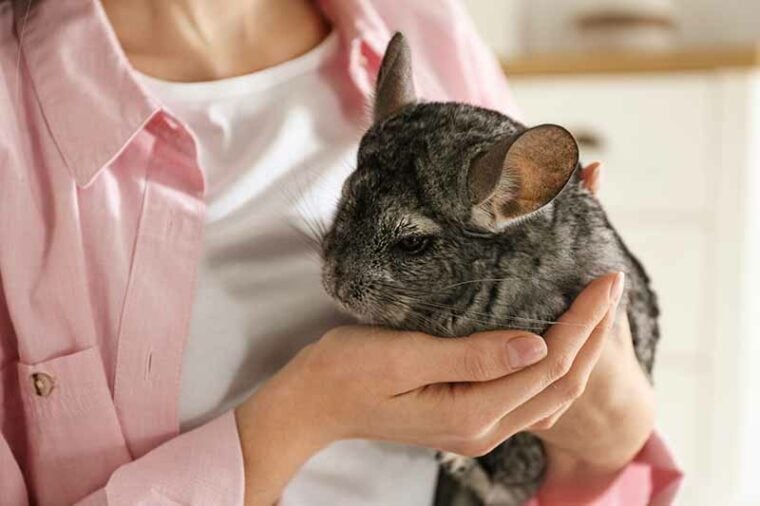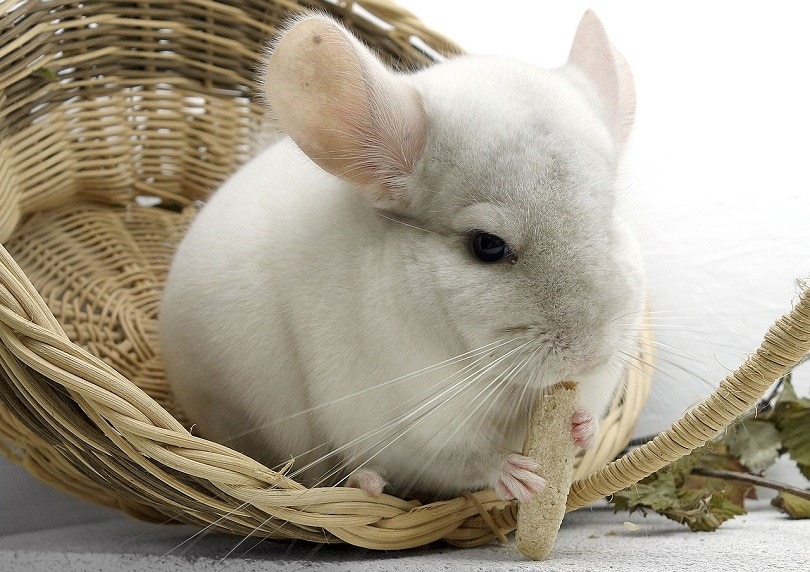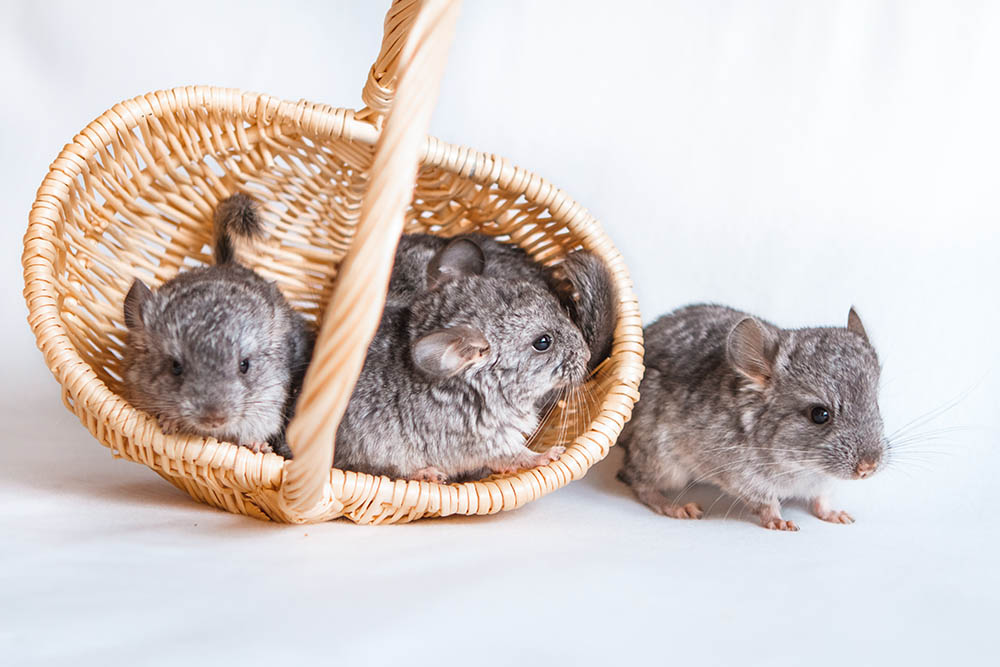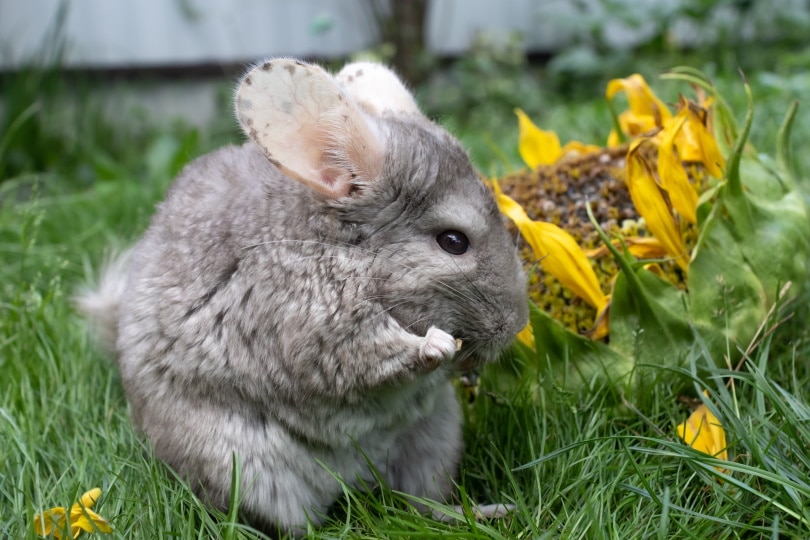
Chinchillas are an appealing and cute rodent originating from South America. Naturally residing in the mountains of places like Chile and Argentina, they are used to living in higher altitudes with elevations over 4,000 meters and rocky environments, where they make homes within the crevices.
Their coats are exceptionally soft and dense, and unfortunately, this has made their fur a valuable commodity. Sadly, their numbers in the wild are declining due to being hunted for their fur, and they are now classed as endangered.
However, over the years, chinchillas have also been bred (and still are) as domestic pets. They live around 10–20 years and have quiet, loving, and curious temperaments. They are popular as pets, as they look and feel adorable and cuddly, but they are sensitive creatures that can become stressed very easily; therefore, they are better suited to adults and older children. If you are considering getting a chinchilla as a pet, check out these top 10 must-knows first.
The 10 Things to Know Before Getting a Chinchilla as a Pet
1. They Are Nocturnal Creatures
Chinchillas like to be awake during the night hours and sleep during most of the day. These furry delights do not burrow. In the wild, they wedge themselves into crevices within their native rocky mountain terrain. You may notice with your pet chinchilla that they squeeze and huddle themselves into small spaces to rest and sleep.

2. They Require Dust Baths
Your chinchilla will require a dust bath rather than a water bath. While there is a purpose to the dust bath, they also really enjoy these! In their natural environments, they roll in volcanic ash or dirt to keep their thick, soft fur clean, shiny, and free from excessive oils and to keep their fur in a good overall healthy condition.
Special chinchilla dust is available commercially, and they require a dust bath two to three times a week in a designated (and appropriate) dust box or set-up. The dust bath procedure should be discussed with your vet or an exotic expert to ensure you are offering and maintaining this important element correctly.
3. Chinchillas Like to Chew
Chinchillas love to chew. The main reason for chewing is to maintain their teeth length and health (see next point). Appropriate items for them to chew and gnaw on need to be provided in their housing. In the wild, they would chew on shrubbery and vegetation, but in a domestic environment, you will need to purchase chinchilla-friendly chew toys and aids.
4. Their Teeth Constantly Grow
Many rodents, like guinea pigs for example, have teeth that constantly grow, and they need to keep these worn down to suitable lengths to prevent an array of dental and eating problems. This can be done by providing appropriate wooden objects for your pet to chew on. These may be bought from your pet store or specialist, and they are safely designed specifically for this chinchilla activity.
Keeping their teeth at an appropriate length is vital, and if you find they are not wearing them down or they have a misalignment preventing them from doing so, then a visit to the vet will be needed.

5. They Are Fast and Athletic
These creatures are fast and very agile. They have long legs, enabling them to leap high. They can, in fact, jump up many feet and have been known to be able to jump on top of refrigerators.
6. They Are Social Animals
In the wild, chinchillas live in colonies of up to 100 other chinchillas. This is a fact to be mindful of, as living solo and being the only chinchilla in a cage is cause for stress and unhappiness for your new pet. So, strongly consider at least getting two pet chinchillas if you’re dedicated to their well-being.
7. Chinchillas Are Herbivores
In their native environments, chinchillas eat plenty of stems, leaves, seeds, and bark that provide them with a lot of fiber. In a domestic situation, they don’t have access to such foods and, therefore, need to be provided with a diet that is very high in fiber. This is reached by providing a daily diet consisting mainly of Timothy Hay.
They tend to eat twice a day (early morning and late evening) and will require other foods and nutritional elements on top of the hay. These are best discussed with a veterinarian or expert to prevent any malnutrition and illness that can follow by being fed an inappropriate diet. Water needs to be constantly provided by a sipper bottle or water bowl.

8. Prone to Hyperthermia (Heat Stroke)
Chinchillas are best kept indoors, especially in climates like the UK and many parts of the US. They prefer sand to thrive in cooler environments and are prone to heat stroke (overheating). Be careful not to place their cage in sunny areas of the home or near radiators/heating systems. The ideal room temperature for chinchillas is between 60–75°F.
9. They Do Not Need Vaccinations
Chinchillas do not require or need any vaccinations, although spaying and neutering need to be considered.
10. Chinchillas Need Space and Suitably Sized Cages
Chinchillas require a large, secure, and quiet space to dart around in, so an appropriately sized cage, run, and set up needs to be purchased (or made) to comfortably provide space and activity for at least one chinchilla. Before getting your pet, consider if you have the space to accommodate this large abode.
They also have sensitive hearing, with a hearing range similar to ours; therefore, the cage and run also need to be in a quiet area of the home and away from loud and sudden noises, as these startle and frighten them.

Conclusion
Chinchillas, like many exotic animals, may be cute and inviting to look at, but they are a complicated commitment requiring specific husbandry, food, and lifestyle. They can also live for up to 20 years, so you need to be in it for the long haul. However, if these rodents are researched correctly and cared for properly, you can enjoy your new pet for many years. Be sure to purchase them from reputable breeders, stores, rescue centers, or charity organizations.
See Also:
Featured Image Credit: New Africa, Shutterstock








